Colloquia for Fall 2015
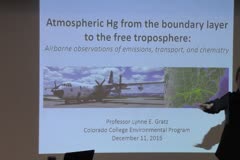
Atmospheric Mercury from the Boundary Layer to the Free Troposphere: Airborne Observations of Emissions, Transport, and Chemistry
December 11, 2015
Lynne E. Gratz
Hosted by Emily Fischer
Mercury (Hg) is a bioaccumulative neurotoxin that is emitted to the atmosphere from both natural and anthropogenic sources. Once in the atmosphere, chemistry and transport are fundamental in determining the introduction of Hg to terrestrial and aquatic ecosystems. While gaseous elemental mercury (Hg(0)) may remain in the atmosphere for months, chemical conversion to the more soluble oxidized…
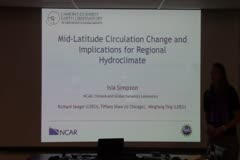
The Mid-Latitude Circulation Response to Global Warming and Implications for Regional Hydroclimate
December 04, 2015
Isla Simpson
Hosted by Libby Barnes
A critical aspect of human-induced climate change is how it will affect regional hydroclimate around the world. To leading order, the increased ability of the atmosphere to hold moisture as it warms, intensifies moisture transports, making sub-tropical dry regions drier and mid- to high latitude wet regions wetter. But regional changes in hydroclimate will also depend on how the atmospheric…
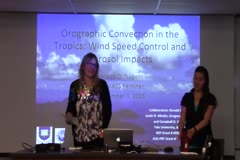
Orographic Convection and Precipitation in the Tropics: Wind Speed Control and Aerosol Interactions
December 03, 2015
Alison D. Nugent
Hosted by
The Dominica Experiment (DOMEX) took place in the eastern Caribbean in the spring of 2011 with 21 research flights of the University of Wyoming King Air (UWKA) aircraft. The goal was an improved understanding of the physics of convective orographic precipitation in the tropics. The UWKA measured upstream and downstream airflow properties as well as the convective clouds and precipitation over…
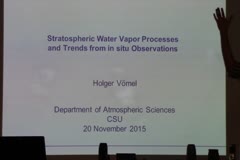
Stratospheric Water Vapor Processes and Trends from in situ Observations
November 20, 2015
Holger Vömel
Hosted by Thomas Birner
Stratospheric water vapor plays an important role in global climate, stratospheric chemistry and polar ozone destruction. Observations of water vapor in the stratosphere and most importantly in the tropical tropopause region are important tools to study trends and processes of stratospheric water vapor. In situ measurements of stratospheric water vapor, ozone, and temperature using small…
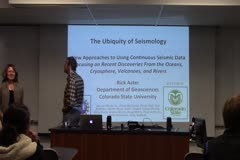
The Ubiquity of Seismology
November 13, 2015
Rick Aster
Hosted by Sonia Kreidenweis
Increased recognition of the deep value of continuous recordings of Earth's seismic wavefield has led to the discovery of a bestiary of new seismogenic processes as well as to the development of powerful new analysis methods. I will summarize representative historic and recent results from research arising from long-duration signals in areas of research that lie outside of the realm of…
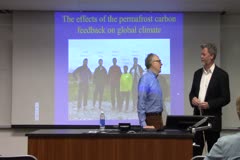
The impact of the permafrost carbon feedback on global climate
November 06, 2015
Kevin Schaefer
Hosted by Scott Denning
Permafrost is permanently frozen ground covering 24% of the northern hemisphere land surface and contains 1100 Gt of carbon in the form of frozen organic matter. Temperatures in the high northern latitudes are increasing twice as fast as the global average. As temperatures continue to increase and the permafrost begins to thaw, the organic matter will also thaw. Once thawed, the organic…
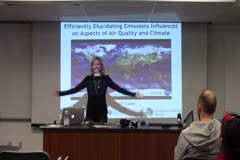
Efficiently Elucidating Emissions Influences on Aspects of Air Quality and Climate
October 30, 2015
Shannon Capps
Hosted by Tammy Thompson
Anthropogenic influence on the composition of the atmosphere has caused harm to human health, shifts in climate, and perturbations to ecosystems. Assessing the relative influence of specific sources on various air quality and climate endpoints enables evaluation of tradeoffs between emissions reduction strategies and technological pathways to meeting environmental goals. The adjoint of a model…
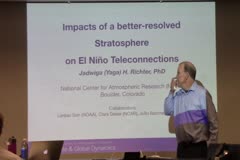
Impacts of a better-resolved stratosphere on El Nino teleconnections
October 23, 2015
Jadwiga (Yaga) H. Richter
Hosted by Dave Randall
The effects of the tropical Pacific El Nino-Southern Oscillation (ENSO) phenomenon are communicated to the rest of the globe via atmospheric teleconnections. Traditionally, ENSO teleconnections have been viewed as tropospheric phenomena, propagating to higher latitudes as Rossby waves. Recent studies, however, suggest an influence of the stratosphere on extra-tropical ENSO teleconnections. The…
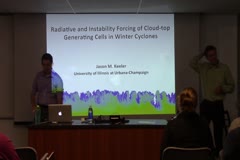
Radiative and Instability Forcing of Cloud-top Generating Cells in Winter Cyclones
October 16, 2015
Jason M. Keeler
Hosted by Russ Schumacher
Recent field observations from the Profiling of Winter Storms (PLOWS) campaign suggest that cloud-top precipitation generating cells (GCs) are ubiquitous in the warm-frontal and comma-head regions of midlatitude winter cyclones. The presence of fall streaks emanating from the GCs, and their persistence either to the surface or until merging into precipitation bands suggests that GCs are a…
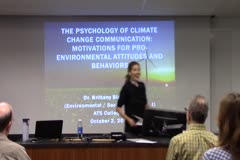
The Psychology of Climate Change Communication: Motivations for Pro-Environmental Attitudes and Behaviors
October 02, 2015
Dr. Brittany Bloodhart
Hosted by Emily Fischer
How do people think about environmental problems like climate change, and why do some people feel concerned or take action? Despite large consensus among the scientific community, many individuals deny that climate change is happening or that it is a serious issue. Although there are many possible reasons why people disengage from the issue, a common link is that they do not feel personally…
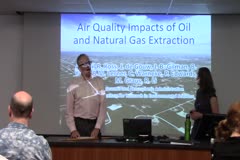
Air quality impacts of oil and natural gas extraction
September 25, 2015
Abigail Koss
Hosted by Scott Denning
Natural gas, crude oil, and natural gas liquids are major fuel sources in the US, and extraction of these resources has been rising substantially since the mid 2000's. This activity is associated with a range of possible environmental issues, including air quality impacts on local, regional, and global scales. Field observations of air chemistry are crucial in order to understand the extent and…
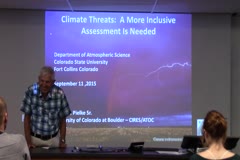
Climate Threats: A More Inclusive Assessment Is Needed
September 11, 2015
Roger A. Pielke, Sr.
Hosted by Bill Cotton
The natural causes of global, regional, and local climate variations and changes are important, but the human influences are also significant. However, the Intergovernmental Panel on Climate Change (IPCC) and other climate assessments have too narrowly focused on CO2 and a few other greenhouse gases in altering local, regional and global climate and their effects on multi-decadal…
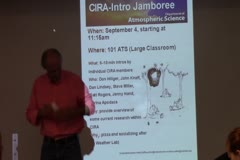
CIRA Intro Jamboree
September 04, 2015
Don Hillger, John Knaff, Dan Lindsey, Steve Miller, Matt Rogers, Jenny Hand, Karina Apodaca
Hosted by
5-10 min intros by individual CIRA members.
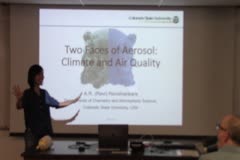
ATS Faculty Jamboree
August 24, 2015
ATS Faculty
Hosted by
Available ATS faculty will give short overviews of their research. Professors who will speak and their topics are as follows: University Distinguished Professor A. R. Ravishankara Understanding the role of aerosols and tropospheric ozone in climate and air quality issues Associate Professor Jeff Pierce The climate and health effects of atmospheric particles Professor Chris…
